Use of Climate Information in Water Allocation: A Case of Study in a Semiarid Region
Abstract
1. Introduction
2. Study Area
3. Materials and Method
3.1. Climate Seasonal Forecast System
 ) as a basis. These forecasts are updated in October (
) as a basis. These forecasts are updated in October ( ). In January (
). In January ( ), another update occurs using dynamic models. From then on, climate and hydrological forecasts are issued monthly until April (
), another update occurs using dynamic models. From then on, climate and hydrological forecasts are issued monthly until April ( ). The time horizon for water allocation discussed in July is 18 months. It focuses on the quality of the rainy season of the following year, as water inflow to the state’s reservoirs is typically not observed from July to December. The forecast system with the S2S approach is not explored in this article. The analysis here focuses on seasonal forecasts issued in January.
). The time horizon for water allocation discussed in July is 18 months. It focuses on the quality of the rainy season of the following year, as water inflow to the state’s reservoirs is typically not observed from July to December. The forecast system with the S2S approach is not explored in this article. The analysis here focuses on seasonal forecasts issued in January.3.2. Hydrological Forecasts
3.3. Metrics of Performance
3.3.1. Climate Model
3.3.2. Hydrological Model
3.4. Reservoir Operations
4. Results
4.1. Atmospheric Model Forecasts: Northeast Region
4.2. Atmospheric Model Forecasts: Strategic Reservoir Basins
4.3. Forecasts of Inflows into the Strategic Reservoirs
4.4. Reservoir Operation Incorporating Inflow Forecasts
5. Conclusions
Author Contributions
Funding
Data Availability Statement
Conflicts of Interest
References
- Doblas-Reyes, F.J.; García-Serrano, J.; Lienert, F.; Biescas, A.P.; Rodrigues, L.R.L. Seasonal climate predictability and forecasting: Status and prospects. WIREs Clim. Chang. 2013, 4, 245–268. [Google Scholar] [CrossRef]
- Li, H.; Luo, L.; Wood, E.F. Seasonal hydrologic predictions of low-flow conditions over eastern USA during the 2007 drought. Atmos. Sci. Lett. 2008, 9, 61–66. [Google Scholar] [CrossRef]
- Sankarasubramanian, A.; Lall, U.; Souza Filho, F.A.; Sharma, A. Improved water allocation utilizing probabilistic climate forecasts: Short-term water contracts in a risk management framework. Water Resour. Res. 2009, 45. [Google Scholar] [CrossRef]
- Sharma, K.; Gosain, A. Application of Climate Information and Predictions in Water Sector: Capabilities. Procedia Environ. Sci. 2010, 1, 120–129. [Google Scholar] [CrossRef]
- Kaune, A.; Chowdhury, F.; Werner, M.; Bennett, J. The benefit of using an ensemble of seasonal streamflow forecasts in water allocation decisions. Hydrol. Earth Syst. Sci. 2020, 24, 3851–3870. [Google Scholar] [CrossRef]
- Martins, E.S.P.R.; Reis Júnior, D.S. Drought Impacts and Policy Responses in Brazil: The Case of the Northeast Region; Special Report on Drought 2021/Global Assessment Report on Disaster Risk Reduction; United Nations: New York, NY, USA, 2021; p. 30. [Google Scholar]
- Ceglar, A.; Toreti, A. Seasonal climate forecast can inform the European agricultural sector well in advance of harvesting. NPJ Clim. Atmos. Sci. 2021, 4, 42. [Google Scholar] [CrossRef]
- Hamlet, A.F.; Huppert, D.; Lettenmaier, D.P. Economic Value of Long-Lead Streamflow Forecasts for Columbia River Hydropower. J. Water Resour. Plan. Manag. 2002, 128, 91–101. [Google Scholar] [CrossRef]
- Kim, K.H.; Shin, Y.; Lee, S.; Jeong, D. Use of Seasonal Climate Forecasts in Agricultural Decision-Making for Crop Disease Management. In Adaptation to Climate Change in Agriculture; Springer: Singapore, 2019; pp. 173–191. [Google Scholar] [CrossRef]
- Thomson, M.C.; Doblas-Reyes, F.J.; Mason, S.J.; Hagedorn, R.; Connor, S.J.; Phindela, T.; Morse, A.P.; Palmer, T.N. Malaria early warnings based on seasonal climate forecasts from multi-model ensembles. Nature 2006, 439, 576–579. [Google Scholar] [CrossRef]
- Ceccato, P.; Ghebremeskel, T.; Jaiteh, M.; Graves, P.M.; Levy, M.; Ghebreselassie, S.; Ogbamariam, A.; Barnston, A.G.; Bell, M.; del Corral, J.; et al. Malaria stratification, climate, and epidemic early warning in Eritrea. Am. J. Trop. Med. Hyg. 2007, 77, 61–68. [Google Scholar] [CrossRef]
- Degallier, N.; Favier, C.; Menkes, C.; Lengaigne, M.; Ramalho, W.M.; Souza, R.; Servain, J.; Boulanger, J.P. Toward an early warning system for dengue prevention: Modeling climate impact on dengue transmission. Clim. Chang. 2010, 98, 581–592. [Google Scholar] [CrossRef]
- Lowe, R.; Bailey, T.C.; Stephenson, D.B.; Graham, R.J.; Coelho, C.A.S.; Sá Carvalho, M.; Barcellos, C. Spatio-temporal modelling of climate-sensitive disease risk: Towards an early warning system for dengue in Brazil. Comput. Geosci. 2011, 37, 371–381. [Google Scholar] [CrossRef]
- Souza Filho, F.A.; Lall, U. Seasonal to interannual ensemble streamflow forecasts for Ceara, Brazil: Applications of a multivariate, semiparametric algorithm. Water Resour. Res. 2003, 39, 1–13. [Google Scholar] [CrossRef]
- Reis, D.; Martins, E.; Nascimento, L.S.; Costa, A.; Alexandre, A. Monthly Streamflow Forecasts for the State of Ceará, Brazil; IAHS-AISH Publication: Wallingford, UK, 2007; pp. 158–166. [Google Scholar]
- Block, P.J.; Souza Filho, F.A.; Sun, L.; Kwon, H.H. A streamflow forecasting framework using multiple climate and hydrological models. J. Am. Water Resour. Assoc. 2009, 45, 828–843. [Google Scholar] [CrossRef]
- Kwon, H.H.; de Assis de Souza Filho, F.; Block, P.; Sun, L.; Lall, U.; Reis, D.S. Uncertainty assessment of hydrologic and climate forecast models in Northeastern Brazil. Hydrol. Process. 2012, 26, 3875–3885. [Google Scholar] [CrossRef]
- de Araújo, C.B.C.; Neto, S.A.D.; Filho, F.D.A.S. Streamflow forecasting for the dam Orós/Ce from hydrometeorological data using perceptrons. Rev. Bras. De Meteorol. 2015, 30, 37–46. [Google Scholar] [CrossRef]
- Silveira, C.d.S.; Alexandre, A.M.B.; de Souza Filho, F.d.A.; Vasconcelos Junior, F.d.C.; Cabral, S.L. Monthly streamflow forecast for National Interconnected System (NIS) using Periodic Auto-regressive Endogenous Models (PAR) and Exogenous (PARX) with climate information. RBRH 2017, 22. [Google Scholar] [CrossRef]
- Delgado, J.M.; Voss, S.; Bürger, G.; Vormoor, K.; Murawski, A.; Rodrigues Pereira, J.M.; Martins, E.; Vasconcelos Júnior, F.; Francke, T. Seasonal drought prediction for semiarid northeastern Brazil: Verification of six hydro-meteorological forecast products. Hydrol. Earth Syst. Sci. 2018, 22, 5041–5056. [Google Scholar] [CrossRef]
- Costa, A.C.; Estacio, A.B.S.; de Souza Filho, F.d.A.; Lima Neto, I.E. Monthly and seasonal streamflow forecasting of large dryland catchments in Brazil. J. Arid Land 2021, 13, 205–223. [Google Scholar] [CrossRef]
- Escada, P.; Coelho, C.A.; Taddei, R.; Dessai, S.; Cavalcanti, I.F.; Donato, R.; Kayano, M.T.; Martins, E.S.; Miguel, J.C.; Monteiro, M.; et al. Climate services in Brazil: Past, present, and future perspectives. Clim. Serv. 2021, 24, 100276. [Google Scholar] [CrossRef]
- Campos, J.N.B. Secas e políticas públicas no semiárido: Ideias, pensadores e períodos. Estud. Avançados 2014, 28, 65–88. [Google Scholar] [CrossRef]
- Erwin De, N.; Engle, N.L.; Magalhães, A.R. Secas no Brasil: Política e Gestão Proativas; Centro de Gestão e Estudos Estratégicos- CGEE - Banco Mundial: Brasília-DF, Brazil, 2016; pp. 37–48. [Google Scholar]
- Lemos, M.C.; Puga, B.P.; Formiga-Johnsson, R.M.; Seigerman, C.K. Building on adaptive capacity to extreme events in Brazil: Water reform, participation, and climate information across four river basins. Reg. Environ. Chang. 2020, 20, 53. [Google Scholar] [CrossRef]
- Martins, E.S.P.R.; Magalhães, A.R.; Fontenele, D. A seca plurianual de 2010–2017 no Nordeste e seus impactos. Parcerias Estratégicas 2017, 20, 17–40. [Google Scholar]
- Martins, E.S.P.R.; Vasconcelos Júnior, F.d.C. O clima da Região Nordeste entre 2009 e 2017: Monitoramento e previsão. Parcerias Estratégicas 2017, 22, 63–80. [Google Scholar]
- Hastenrath, S.; Heller, L. Dynamics of climatic hazards in northeast Brazil. Q. J. R. Meteorol. Soc. 1977, 103, 77–92. [Google Scholar] [CrossRef]
- Moura, A.D.; Shukla, J. On the Dynamics of Droughts in Northeast Brazil: Observations, Theory and Numerical Experiments with a General Circulation Model. J. Atmos. Sci. 1981, 38, 2653–2675. [Google Scholar] [CrossRef]
- Nobre, P.; Srukla, J. Variations of Sea Surface Temperature, Wind Stress, and Rainfall over the Tropical Atlantic and South America. J. Clim. 1996, 9, 2464–2479. [Google Scholar] [CrossRef]
- Kane, R.P. Prediction of Droughts in North-East Brazil: Role of ENSO and Use of Periodicities. Int. J. Climatol. 1997, 17, 655–665. [Google Scholar] [CrossRef]
- Marengo, J.A.; Torres, R.R.; Alves, L.M. Drought in Northeast Brazil—Past, present, and future. Theor. Appl. Climatol. 2017, 129, 1189–1200. [Google Scholar] [CrossRef]
- Roeckner, E.; Arpe, K.; Bengtsson, L.; Christoph, M.; Claussen, M.; Dümenil, L.; Esch, M.; Giorgetta, M.; Schlese, U.; Schulzweida, U. The Atmospheric General Circulation Model ECHAM-4: Model Description and Simulation of Present-Day Climate; Technical report; Max-Planck Institute for Meteorology: Hamburg, Germany, 1996. [Google Scholar]
- Gates, W.L. AMIP: The Atmospheric Model Intercomparison Project. Bull. Am. Meteorol. Soc. 1992, 73, 1962–1970. [Google Scholar] [CrossRef]
- Gates, W.L.; Boyle, J.S.; Covey, C.; Dease, C.G.; Doutriaux, C.M.; Drach, R.S.; Fiorino, M.; Gleckler, P.J.; Hnilo, J.J.; Marlais, S.M.; et al. An Overview of the Results of the Atmospheric Model Intercomparison Project (AMIP I). Bull. Am. Meteorol. Soc. 1999, 80, 29–56. [Google Scholar] [CrossRef]
- Reynolds, R.W.; Rayner, N.A.; Smith, T.M.; Stokes, D.C.; Wang, W. An Improved In Situ and Satellite SST Analysis for Climate. J. Clim. 2002, 15, 1609–1625. [Google Scholar] [CrossRef]
- Sun, L.; Moncunill, D.F.; Li, H.; Moura, A.D.; de Assis de Souza Filho, F. Climate downscaling over Nordeste, Brazil, using the NCEP RSM97. J. Clim. 2005, 18, 551–567. [Google Scholar] [CrossRef]
- Sun, L.; Li, H.; Zebiak, S.E.; Moncunill, D.F.; Filho, F.D.A.D.S.; Moura, A.D. An Operational Dynamical Downscaling Prediction System for Nordeste Brazil and the 2002–04 Real-Time Forecast Evaluation. J. Clim. 2006, 19, 1990–2007. [Google Scholar] [CrossRef]
- White, C.J.; Domeisen, D.I.; Acharya, N.; Adefisan, E.A.; Anderson, M.L.; Aura, S.; Balogun, A.A.; Bertram, D.; Bluhm, S.; Brayshaw, D.J.; et al. Advances in the Application and Utility of Subseasonal-to-Seasonal Predictions. Bull. Am. Meteorol. Soc. 2022, 103, E1448–E1472. [Google Scholar] [CrossRef]
- Lopes, J.E.G.; Braga, B.P.F.; Conejo, J.G.L. SMAP—A simplified hydrological model. In Applied Modelling in Catchment Hydrology, Proceedings of the International Symposium on Rainfall-Runoff Modelling; Singh, V.P., Ed.; Water Resources Publications: Littleton, CO, USA, 1982; pp. 167–176. [Google Scholar]
- Barros, F.V.F.; Martins, E.S.P.R.; Nascimento, L.S.V.; Reis, D.S. Use of Multiobjective Evolutionary Algorithms in Water Resources Engineering. In Multi-Objective Swarm Intelligent Systems: Theory & Experiences; Springer: Berlin/Heidelberg, Germany, 2010; pp. 45–82. [Google Scholar] [CrossRef]
- Hargreaves, G.H.; Samani, Z.A. Reference Crop Evapotranspiration from Temperature. Appl. Eng. Agric. 1985, 1, 96–99. [Google Scholar] [CrossRef]
- Allen, R.G.; Pereira, L.S.; Raes, D.; Smith, M. Crop Evapotranspiration: Guidelines for Computing Crop Water Requirements; FAO Irrigation and Drainage Paper; FAO: Rome, Italy, 1998. [Google Scholar]
- Xie, P.; Arkin, P.A. Global Precipitation: A 17-Year Monthly Analysis Based on Gauge Observations, Satellite Estimates, and Numerical Model Outputs. Bull. Am. Meteorol. Soc. 1997, 78, 2539–2558. [Google Scholar] [CrossRef]
- Epstein, E.S. A Scoring System for Probability Forecasts of Ranked Categories. J. Appl. Meteorol. 1969, 8, 985–987. [Google Scholar] [CrossRef]
- Wilks, D.S. Statistical Methods in the Atmospheric Sciences; International Geophysics; Elsevier Science: Amsterdam, The Netherlands, 2011. [Google Scholar]
- Nash, J.; Sutcliffe, J. River flow forecasting through conceptual models part I—A discussion of principles. J. Hydrol. 1970, 10, 282–290. [Google Scholar] [CrossRef]
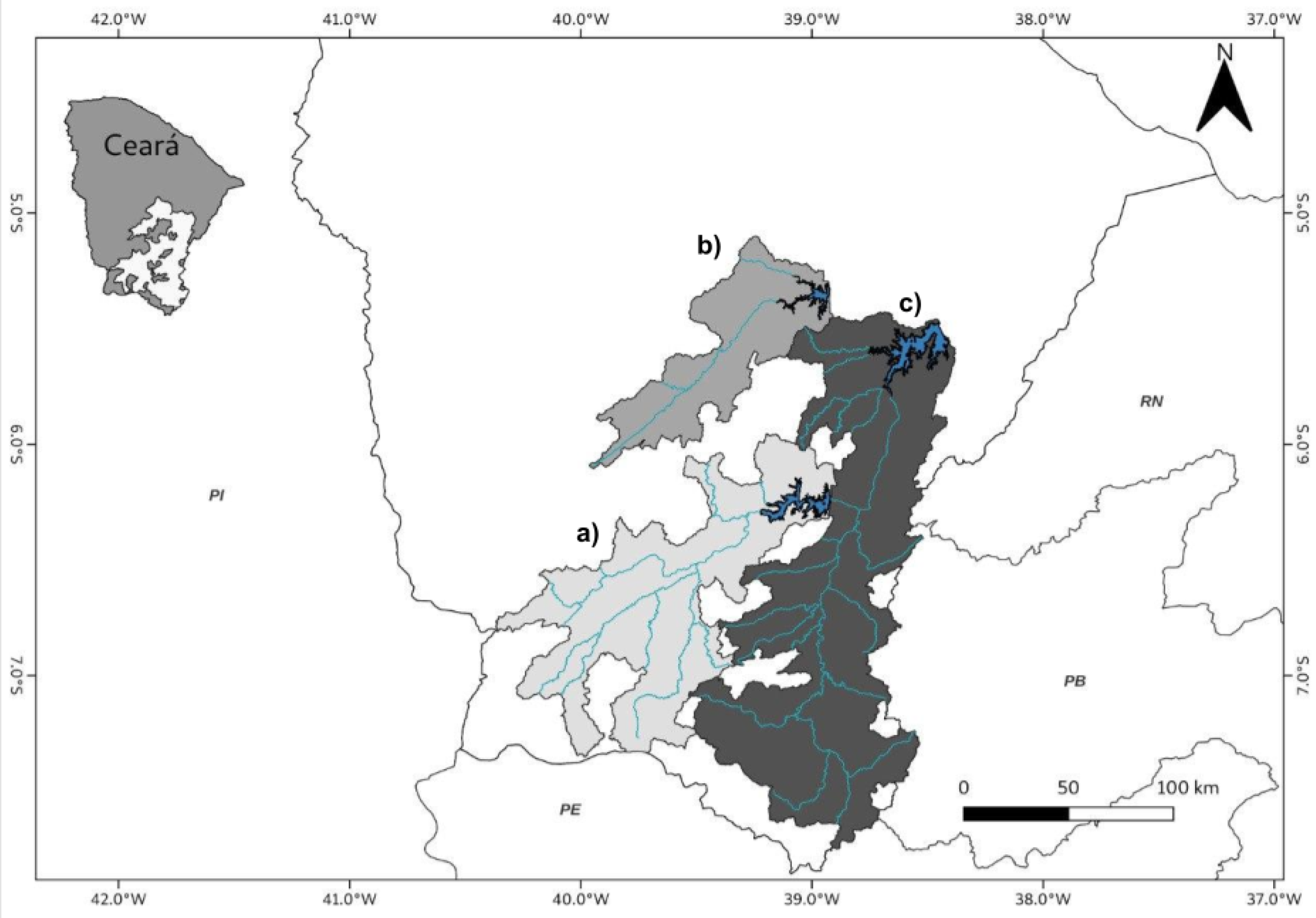
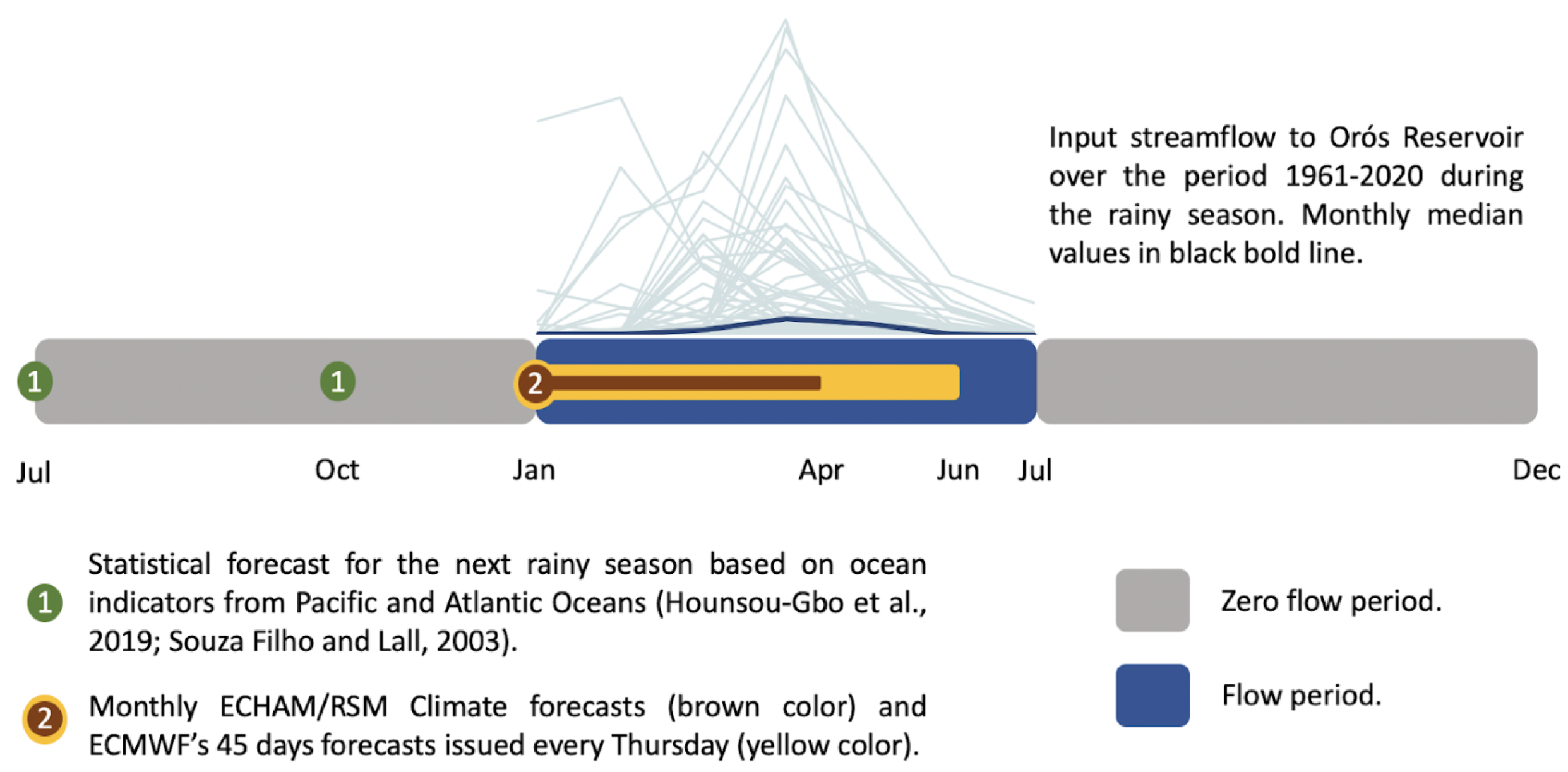
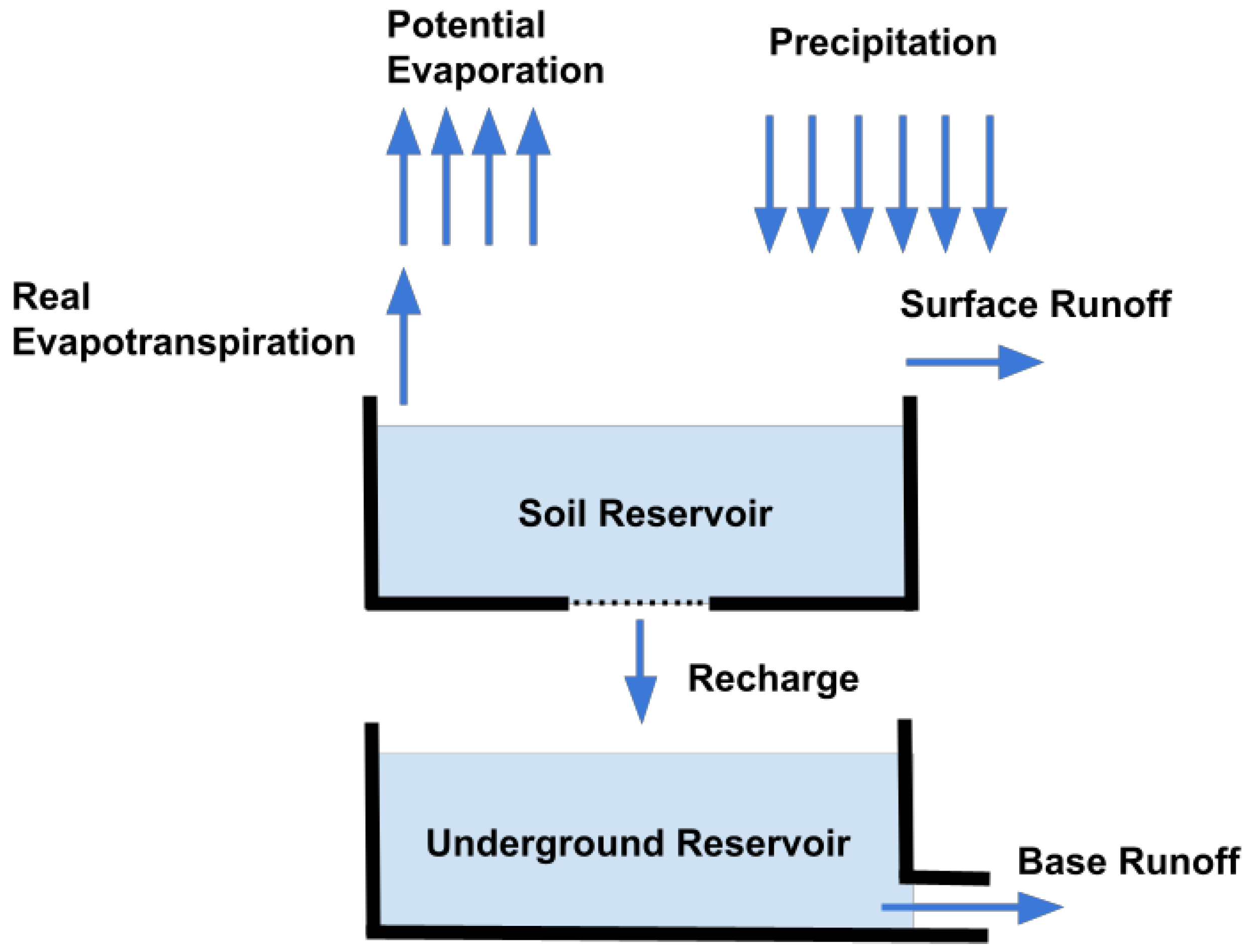
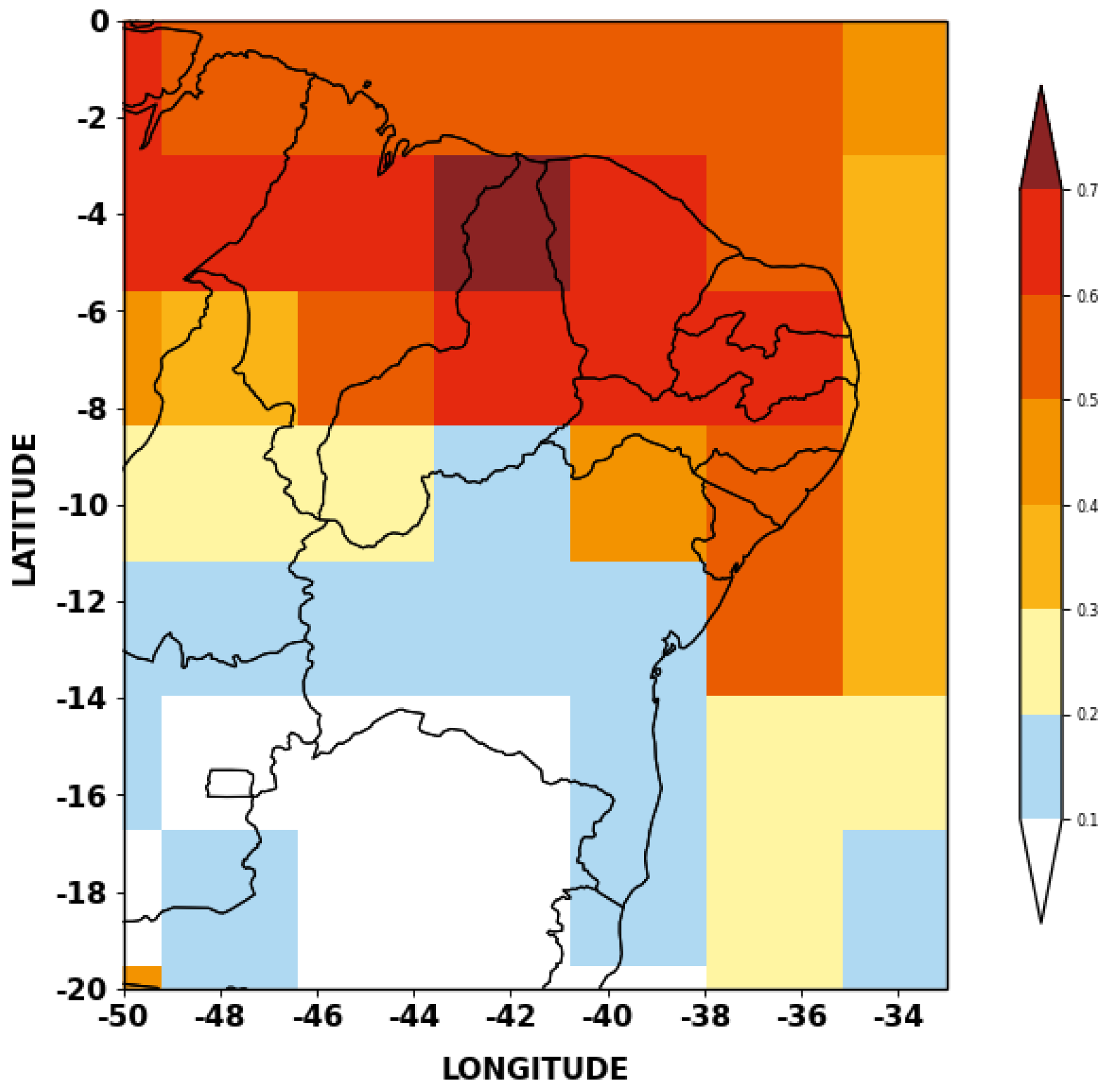
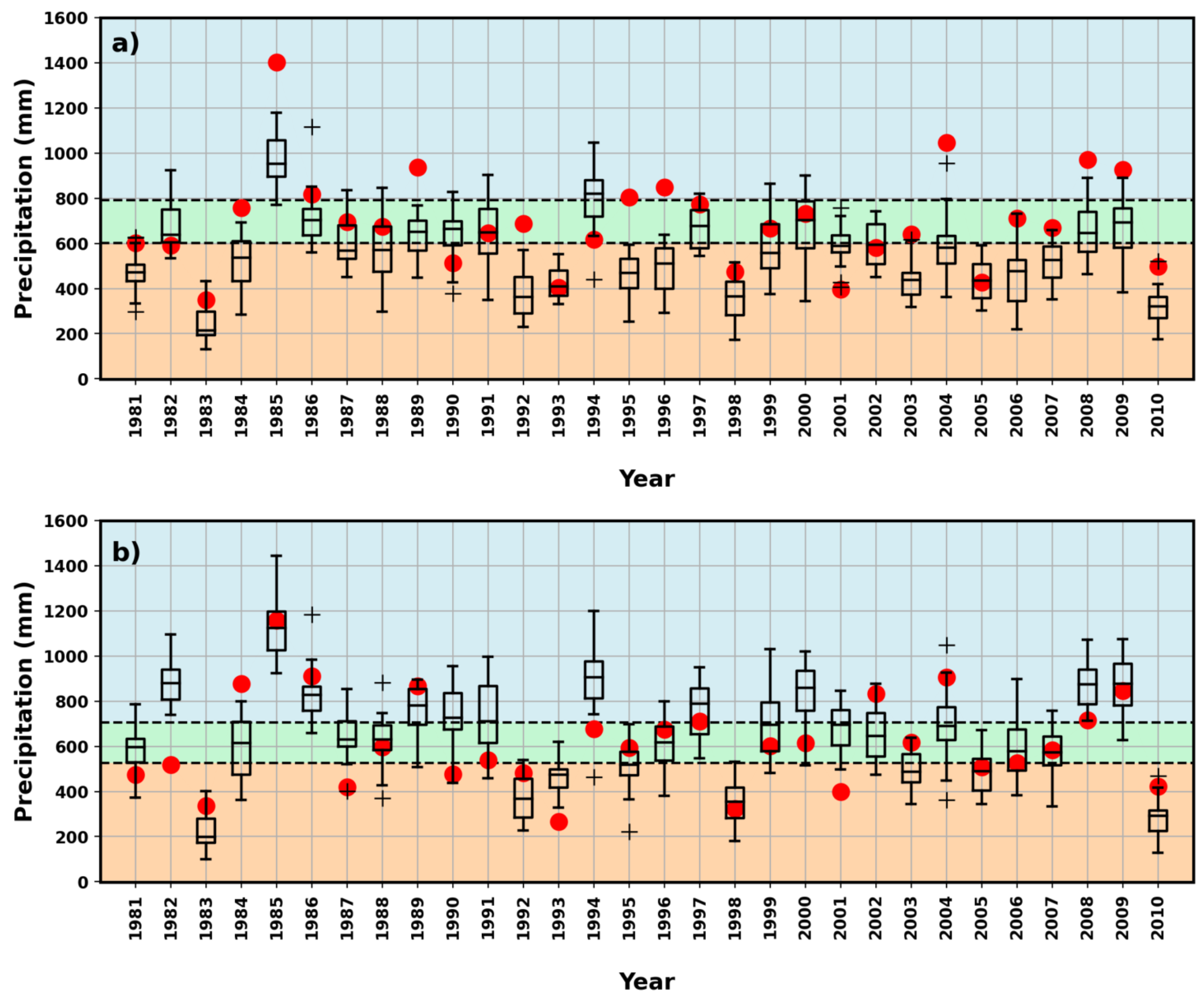
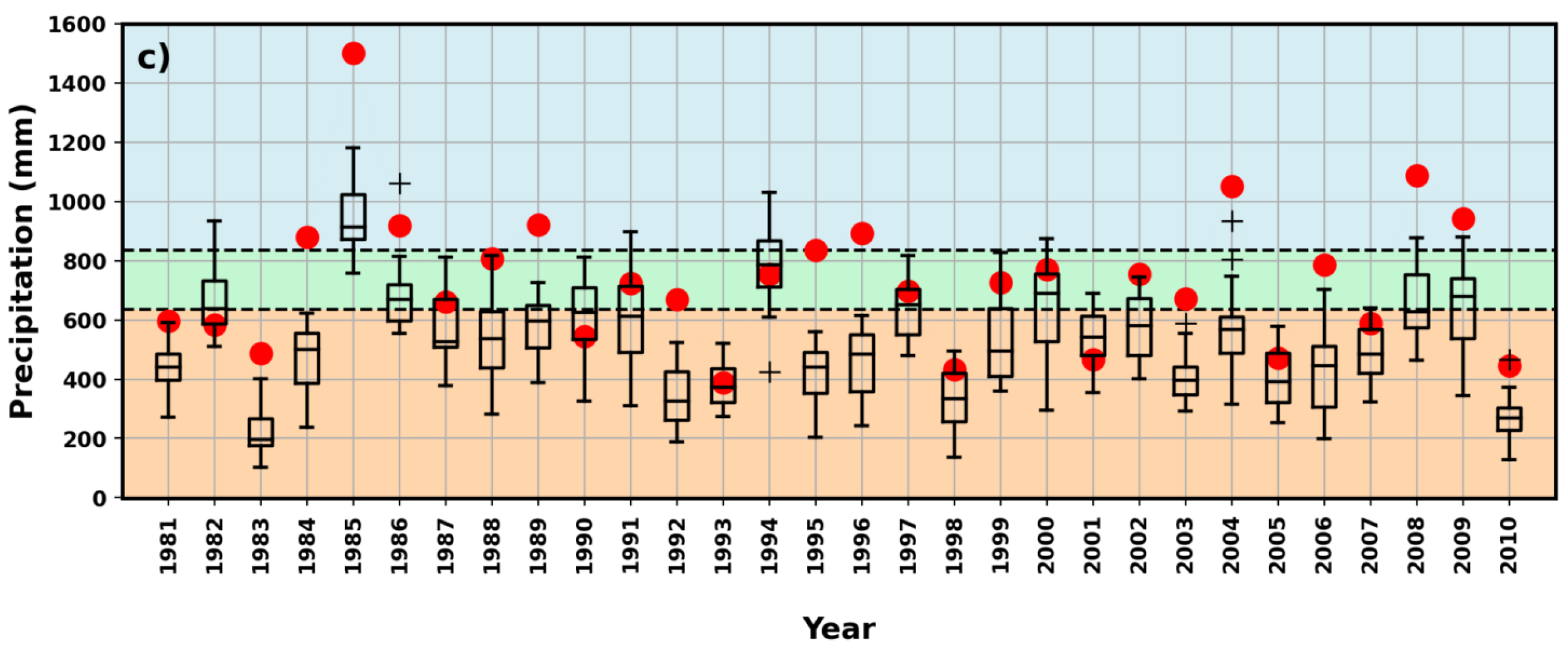
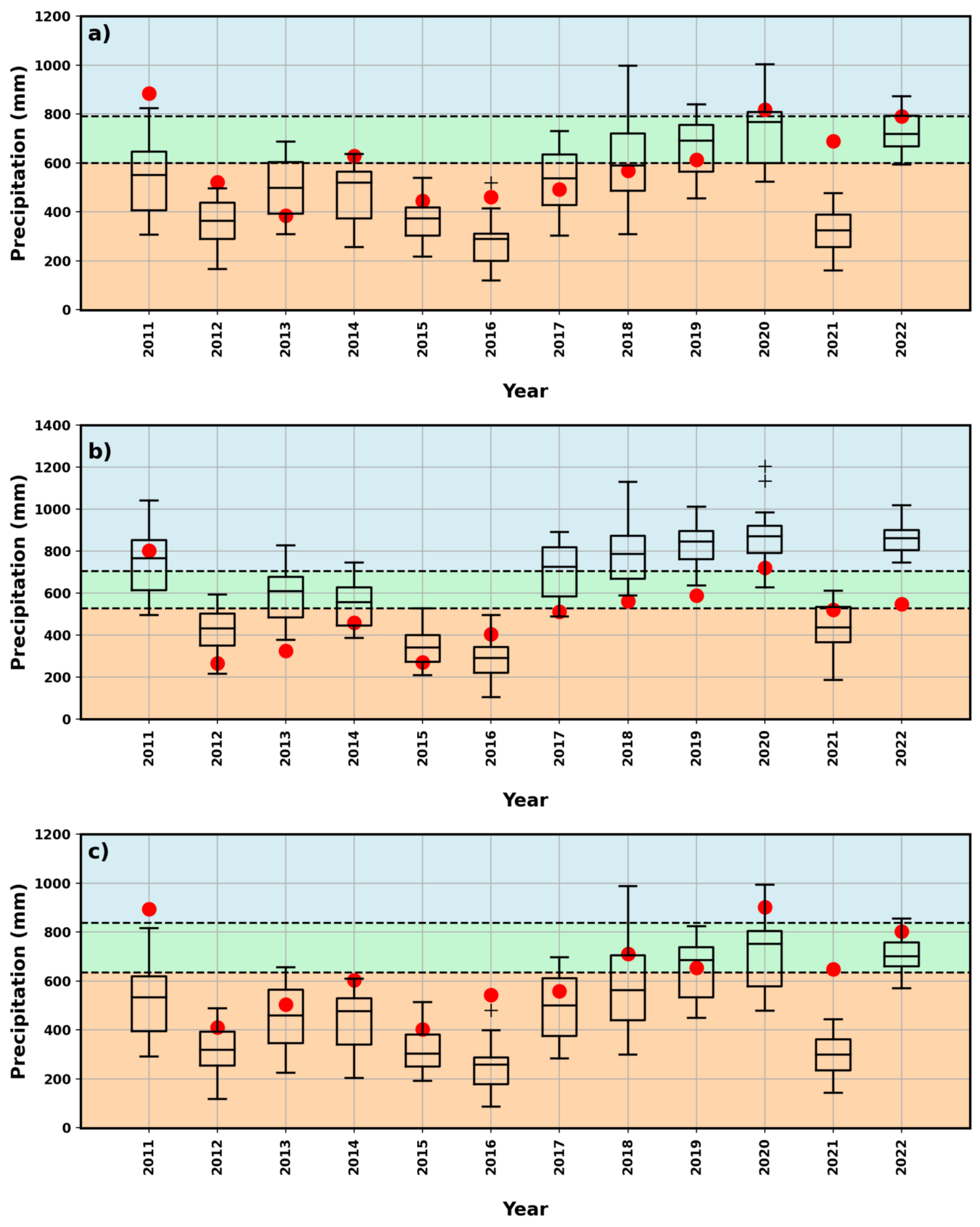
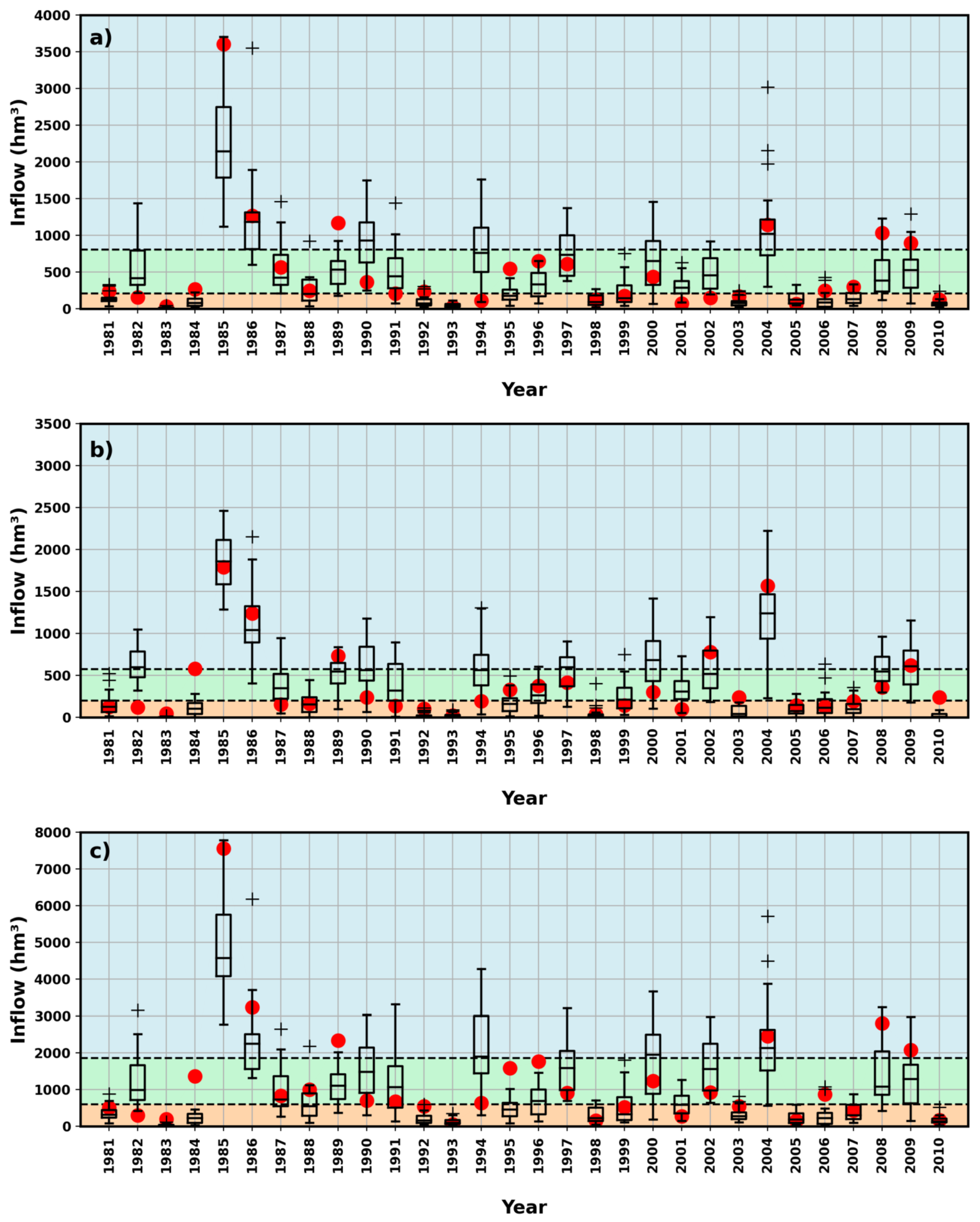
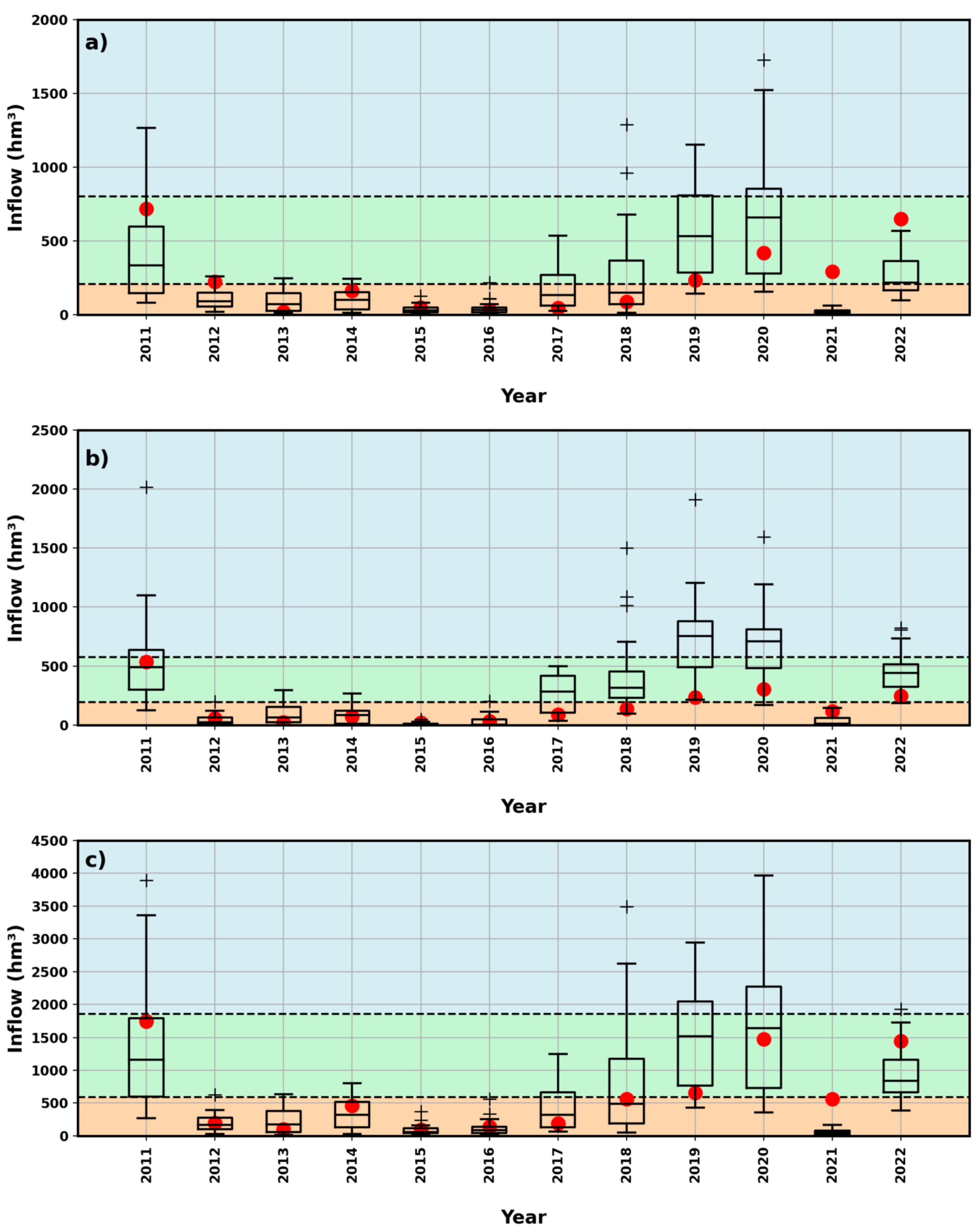
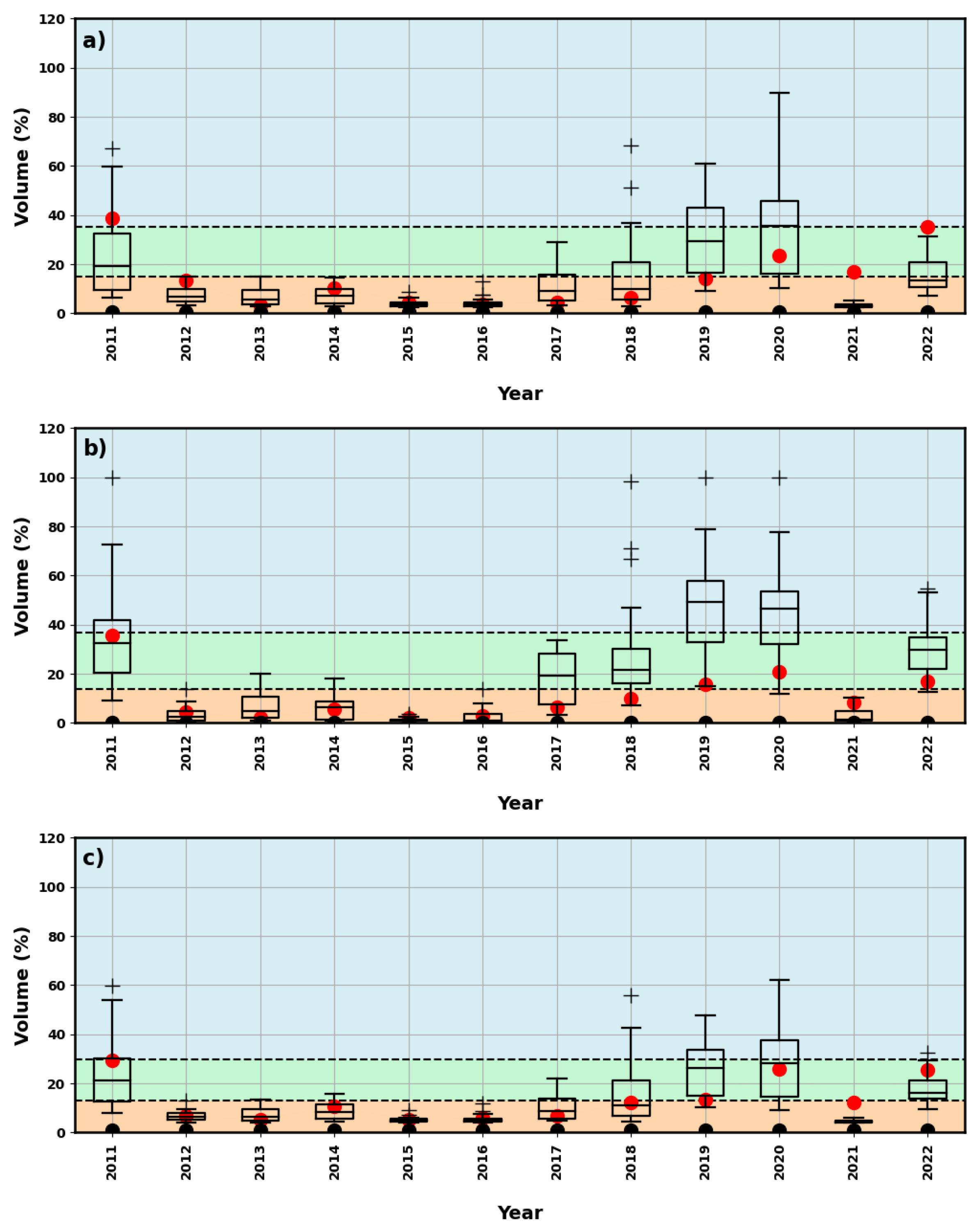
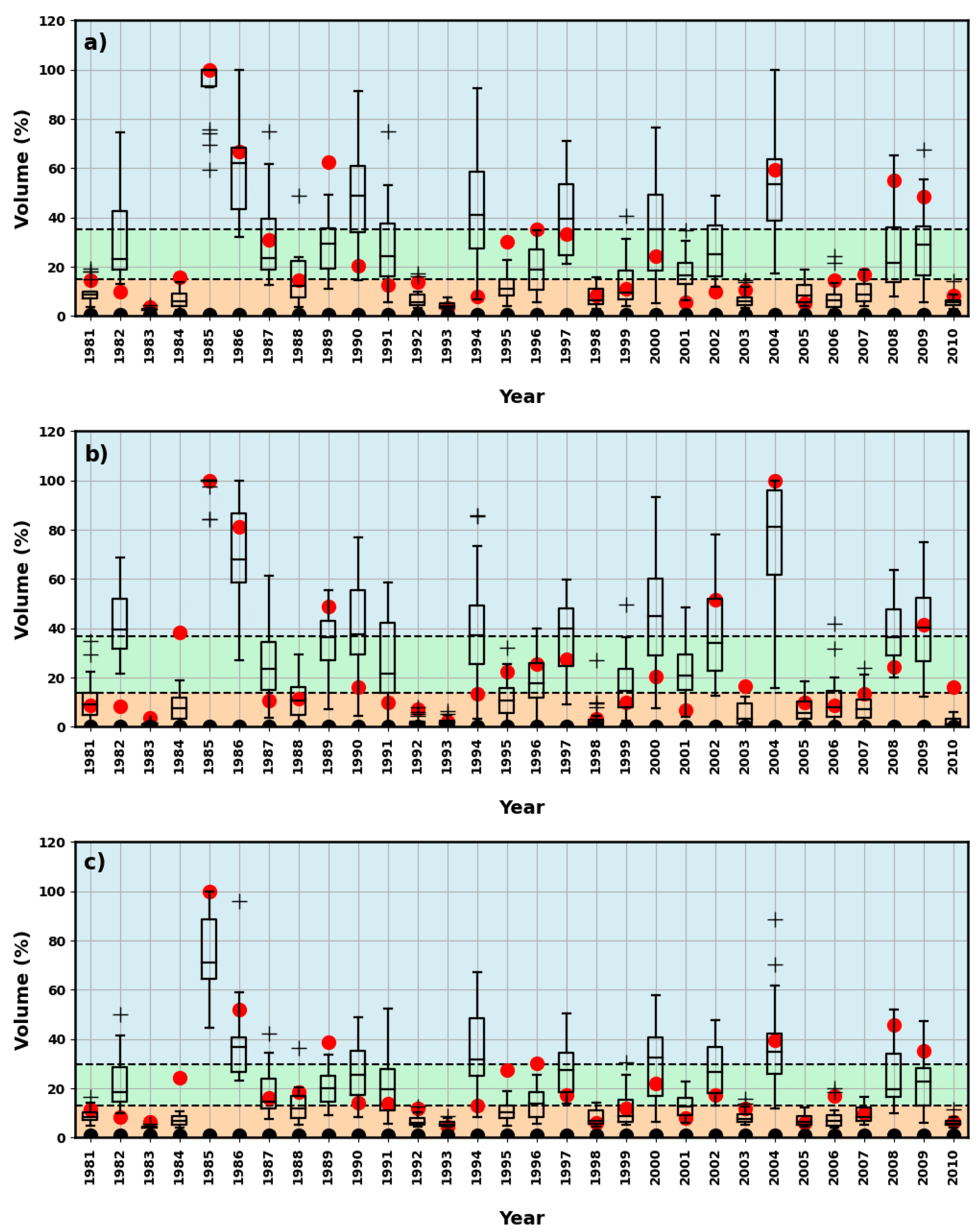
| Reservoir | |||
|---|---|---|---|
| Orós | Banabuiú | Castanhão | |
| Total Basin Area (km2) | 24,960.92 | 14,244.22 | 44,806.33 |
| Storage (hm3) | 1940 | 1601 | 6700 |
| Q10 (hm3) | 67.51 | 8.57 | 153.84 |
| Q25 (hm3) | 129.08 | 27.15 | 199.17 |
| Median (hm3) | 322.01 | 90.27 | 323.69 |
| Q75 (hm3) | 758.72 | 535.05 | 1139.6 |
| Q90 (hm3) | 1438.06 | 836.18 | 1904.24 |
| Mean (hm3) | 628.21 | 331.48 | 877.16 |
| Standard Deviation (hm3) | 831.6 | 495.61 | 1189.73 |
| Reservoir | 1986–2010 | 2011–2022 | 1986–2022 | |||
|---|---|---|---|---|---|---|
| NSE | CORR | NSE | CORR | NSE | CORR | |
| Orós | 0.81 | 0.95 | 0.28 | 0.96 | 0.80 | 0.95 |
| Banabuiú | 0.45 | 0.66 | 0.50 | 0.80 | 0.52 | 0.70 |
| Castanhão | 0.70 | 0.87 | 0.83 | 0.91 | 0.87 | 0.81 |
| Reservoir | 1981–2010 | 2011–2022 | 1981–2022 | |||
|---|---|---|---|---|---|---|
| RPSS | CORR | RPSS | CORR | RPSS | CORR | |
| Orós | 0.13 | 0.61 | 0.31 | 0.50 | 0.19 | 0.60 |
| Banabuiú | 0.26 | 0.66 | 0.38 | 0.67 | 0.30 | 0.66 |
| Castanhão | 0.16 | 0.64 | 0.32 | 0.66 | 0.21 | 0.66 |
| Reservoir | 1981–2010 | 2011–2022 | 1981–2022 | ||||||
|---|---|---|---|---|---|---|---|---|---|
| NSE | RPSS | CORR | NSE | RPSS | CORR | NSE | RPSS | CORR | |
| Orós | 0.69 | 0.19 | 0.82 | 0.12 | 0.43 | 0.47 | 0.68 | 0.25 | 0.81 |
| Banabuiú | 0.72 | 0.24 | 0.83 | −1.40 | 0.18 | 0.71 | 0.66 | 0.22 | 0.81 |
| Castanhão | 0.65 | 0.44 | 0.80 | 0.59 | 0.49 | 0.73 | 0.66 | 0.46 | 0.81 |
| Reservoir | Initial Volume | 1981–2010 | 2011–2022 | 1981–2022 | |||
|---|---|---|---|---|---|---|---|
| RPSS | CORR | RPSS | CORR | RPSS | CORR | ||
| Orós | 10% | 0.24 | 0.73 | 0.26 | 0.47 | 0.25 | 0.73 |
| 25% | 0.24 | 0.69 | 0.26 | 0.47 | 0.24 | 0.70 | |
| 50% | 0.27 | 0.64 | 0.26 | 0.48 | 0.27 | 0.65 | |
| Banabuiú | 10% | 0.25 | 0.79 | 0.46 | 0.69 | 0.31 | 0.78 |
| 25% | 0.25 | 0.76 | 0.46 | 0.69 | 0.31 | 0.75 | |
| 50% | 0.23 | 0.69 | 0.43 | 0.69 | 0.29 | 0.69 | |
| Castanhão | 10% | 0.30 | 0.77 | 0.56 | 0.70 | 0.37 | 0.78 |
| 25% | 0.29 | 0.74 | 0.53 | 0.73 | 0.36 | 0.76 | |
| 50% | 0.25 | 0.67 | 0.41 | 0.72 | 0.29 | 0.70 | |
| Reservoir | Info | % Demands Met at the end of December * | |||||
|---|---|---|---|---|---|---|---|
| =0 | 0↔25 | 25→50 | 50→75 | 75→100 | =100 | ||
| Orós | Fcst. | 18.7 | 19.3 | 0.6 | 0.4 | 21.9 | 21.5 |
| Obs. | 11 | 14 | 1 | 2 | 25 | 25 | |
| Banabuiú | Fcst. | 18.5 | 19.0 | 0.5 | 0.2 | 22.4 | 22.1 |
| Obs. | 18 | 20 | 0 | 0 | 22 | 21 | |
| Castanhão | Fcst. | 15.6 | 16.7 | 0.4 | 0.6 | 24.3 | 23.8 |
| Obs. | 9 | 12 | 0 | 0 | 30 | 30 | |
Disclaimer/Publisher’s Note: The statements, opinions and data contained in all publications are solely those of the individual author(s) and contributor(s) and not of MDPI and/or the editor(s). MDPI and/or the editor(s) disclaim responsibility for any injury to people or property resulting from any ideas, methods, instructions or products referred to in the content. |
© 2023 by the authors. Licensee MDPI, Basel, Switzerland. This article is an open access article distributed under the terms and conditions of the Creative Commons Attribution (CC BY) license (https://creativecommons.org/licenses/by/4.0/).
Share and Cite
Pereira, J.M.R.; Raimundo, C.d.C.; Reis, D.S., Jr.; Vasconcelos, F.d.C., Jr.; Martins, E.S.P.R. Use of Climate Information in Water Allocation: A Case of Study in a Semiarid Region. Water 2023, 15, 2460. https://doi.org/10.3390/w15132460
Pereira JMR, Raimundo CdC, Reis DS Jr., Vasconcelos FdC Jr., Martins ESPR. Use of Climate Information in Water Allocation: A Case of Study in a Semiarid Region. Water. 2023; 15(13):2460. https://doi.org/10.3390/w15132460
Chicago/Turabian StylePereira, José Marcelo Rodrigues, Clebson do Carmo Raimundo, Dirceu Silveira Reis, Jr., Francisco das Chagas Vasconcelos, Jr., and Eduardo Sávio Passos Rodrigues Martins. 2023. "Use of Climate Information in Water Allocation: A Case of Study in a Semiarid Region" Water 15, no. 13: 2460. https://doi.org/10.3390/w15132460
APA StylePereira, J. M. R., Raimundo, C. d. C., Reis, D. S., Jr., Vasconcelos, F. d. C., Jr., & Martins, E. S. P. R. (2023). Use of Climate Information in Water Allocation: A Case of Study in a Semiarid Region. Water, 15(13), 2460. https://doi.org/10.3390/w15132460








